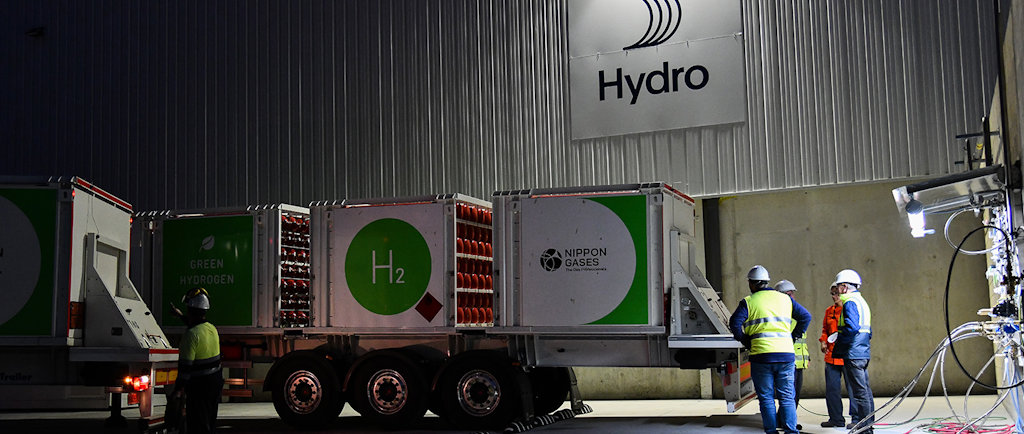Heroes in the field
World-first Aluminium Produced with Renewable Hydrogen
June marked a monumental breakthrough in the aluminium sector as Hydro Havrand, a pioneering force in the industry, achieved an unprecedented milestone in Navarra, Northern Spain. They accomplished a remarkable feat by supporting mother company Hydro in producing the world's inaugural batch of recycled aluminium, powered by renewable hydrogen.

Hydro Havrand was established by Hydro, a prominent Norwegian aluminum and renewable energy company, in line with Hydro’s strategic commitment to lowering its CO2 emissions. The objective of Hydro Havrand is crystal clear: to help industries decarbonise with renewable hydrogen. It’s safe to say that they are making remarkable progress in achieving this objective.
Renewable Hydrogen Breaking Barriers of Aluminium Production
Traditionally, the aluminium industry has relied on natural gas to generate the high temperature heat that is essential for shaping and moulding recycled aluminium. This has long led the sector grappling with the challenge of reducing hard-to-abate emissions. However, this reality is undergoing a profound transformation, as Hydro’s project project in Navarra has vividly demonstrated.
At its Navarra plant, Hydro has replaced natural gas with renewable hydrogen in one casthouse, to further the technology qualification of hydrogen fuel switch solutions. For three weeks, hydrogen was used both as a blend and as only fuel in industrial scale recycling of aluminium – the world’s first test of its kind. The exciting part? Renewable hydrogen proves just as successful as natural gas: this switch does not compromise the quality of the aluminium produced – it remains of the same high quality for all its intended purposes.
In essence, we are ushering in an era of cleaner, more environmentally responsible aluminium production, bidding farewell to carbon-heavy natural gas in favour of renewable hydrogen.
Paving the Way for Zero Carbon Aluminium
The implications of this breakthrough are profound, given that aluminium is one of the most recyclable materials on Earth. By eliminating emissions from the recycling process, manufacturers can aspire to deliver CO2-free aluminium products. Hydro is already at the forefront of this effort, actively working towards creating products from 100% recycled post-consumer scrap. With renewable hydrogen poised to replace natural gas, Hydro inches closer to producing the world’s first zero carbon aluminium.
Challenges in Widespread Adoption
Following their groundbreaking three-week test in Navarra, Hydro Havrand is determined to take this technology to the next level. In simpler terms, they’re working to make it not only operational but also a game-changer for everyday use. Their upcoming pilot project in Norway next year is a crucial step towards achieving full technological maturity in hydrogen-powered aluminium production. But this doesn’t come without challenges.
While embracing renewable hydrogen holds immense promise, there are significant hurdles to clear on the path to its widespread adoption. One of the main challenges is that using renewable hydrogen is more expensive compared to conventional methods using natural gas. This higher cost can make for industries and businesses to make the switch.
In this context, providing substantial financial support for both launching (CAPEX) and sustaining (OPEX) renewable hydrogen projects is not just important—it’s essential. Schemes such as the proposed European Hydrogen Bank are a very promising scheme to do this. It now needs to be back with proper funding and clarity over the auction calendar over the next couple years. This will accelerate the transition to cleaner fuels on a massive scale, making renewable hydrogen a widespread reality.
***
Hydro Havrand’s groundbreaking use of renewable hydrogen in aluminium production signals a significant shift towards cleaner, more sustainable manufacturing. By replacing carbon-heavy natural gas, they’ve demonstrated the effectiveness of renewable hydrogen without compromising product quality. This advancement not only reduces emissions in high-temperature processes but also offers the potential for carbon-neutral aluminium by eliminating emissions during recycling. Challenges remain, including the higher cost of renewable hydrogen. With substantial financial support, we can accelerate the transition to cleaner fuels and make renewable hydrogen a widespread reality, paving the way for a more environmentally responsible future in aluminium production.



